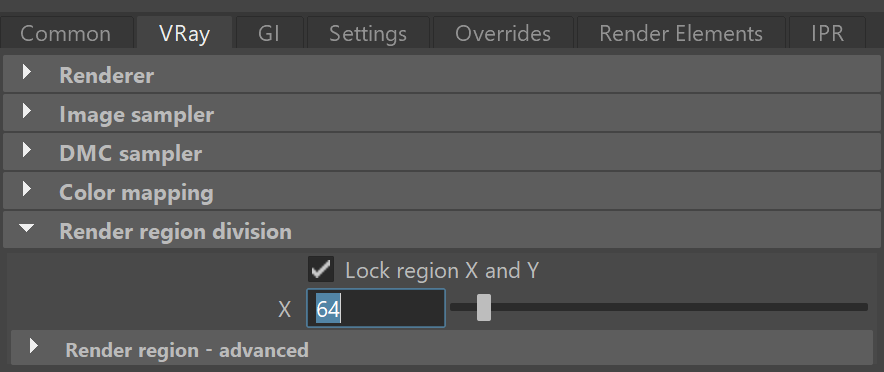This page provides information on the Render Region Division rollout in the Render Settings.
Overview
The parameters in this rollout adjust V-Ray's rendering regions (sometimes referred to as buckets). A bucket is a rectangular (usually square) section of the currently rendered frame that is rendered independently from other sections.
The bucket is an essential part of the V-Ray distributed rendering system. Individual buckets can be sent to idle LAN machines for processing and/or can be distributed between several CPUs on the local machine.
Because a bucket can be processed only by a single processor, the division of the frame in too few buckets can prevent the optimal utilization of computational resources (some CPUs stay idle all the time). However, the division of the frame into too many buckets can slow down the rendering because there is some time overhead related to each bucket (bucket setup, LAN transfer, etc). To handle this problem, V-Ray 3.0 now dynamically reduces the size of the buckets when small parts of the image remain to be rendered.
Render Region Division
Lock region X and Y – Forces the bucket shape to a square by locking the region's X and Y (width and height) together. Enabled by default.
X – Determines the bucket's maximum region width in pixels (when Region W/H is selected for Measurement) or the number of regions in the horizontal direction (when Region Count is selected).
Y – Determines the bucket's maximum region height in pixels (when Region W/H is selected for Measurement) or the number of regions in the vertical direction (when Region Count is selected). This parameter is available only when Lock region X and Y is disabled.
Render Region Advanced
Measurement – Determines the way the X and Y parameters are used to set bucket size:
Region W/H – The values for X and Y are in pixels.
Region Count – The values for X and Y determine the number of regions in the horizontal and vertical direction respectively.
Sequence type – Determines the order in which the regions are rendered.
Top-Bottom – From top to bottom.
Left-Right – From left to right.
Checker – In a checker pattern.
Spiral – In a spiral pattern.
Triangulation – Default, and usually the best choice, especially if you use a lot of dynamic geometry (displacement-mapped objects, proxy objects). This option walks through the image in a consistent manner; it displays information as it is calculated using the most efficient sequence for the current rendering settings, and uses geometry that was generated for previous buckets to render subsequent buckets.
Hilbert Curve – In the pattern of a Hilbert space-filling curve.
Reverse Sequence – Reverses the region sequence order.




